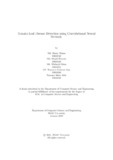Tomato leaf disease detection using convolutional neural network
Date
2023-01Publisher
Brac UniversityAuthor
Hasan, Md. RiazulHossain, Md. Shajib
Islam, Md. Minhajul
Rahman Apu, Md. Rejoanur
Moli, Farzana Akter
Metadata
Show full item recordAbstract
The fertile soil and easy access to water make agriculture more suitable and valu able for Bangladesh. Most people are directly or indirectly dependent on agricultural
products for their livelihood. Agriculture plays an important role in the GDP of
Bangladesh, which is 12.68% in 2019. According to the UN FAO, tomato is a type
of vegetable that is ingested by 16% of the entire population. When analyzing the
agricultural environment in Bangladesh, tomatoes are considered one of the most
common vegetables. Plant infections pose a significant danger to crop production,
yet timely detection remains a challenge in several regions of the world due to a
lack of facilities. Climate changes are forcing us to take more care of agriculture
to ensure food safety. Early detection of diseases has been made possible by cur rent developments in computer vision. Image processing and deep learning are very
useful in this situation. The object’s impacted region is segmented using a bespoke
threshold algorithm based on HBS (hue-based segmentation). Utilizing a color co occurrence approach, the segmented portion’s consequential selected features are
recovered for edge detection. This research shows the diagnosis and detection of
tomato leaf diseases involving several steps, including image capture, image pre processing, picture segmentation, feature extraction, and classification using a Con volutional Neural Network(CNN). The proposed CNN model achieved 95% accuracy
while using much fewer computational resources, which makes it easily deployable
in mobile applications.

